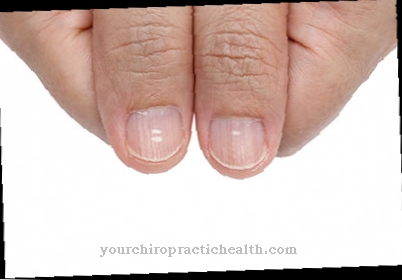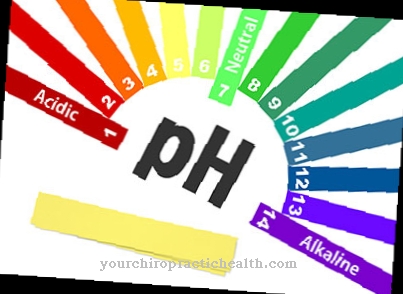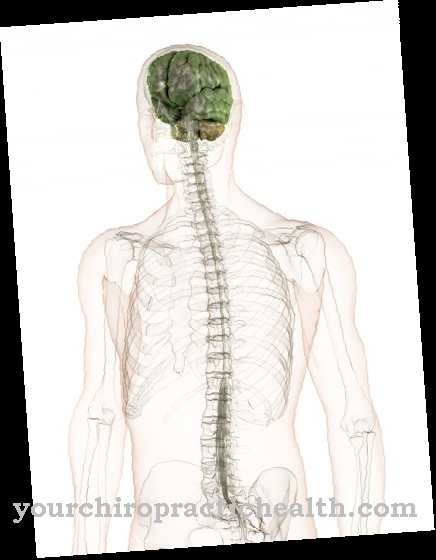The Crigler-Najjar Syndrome is an extremely rare hereditary disease. In patients with this disease, the blood metabolism is disturbed due to a reduced activity of the enzyme UDP-glucuronyl transferase. The therapy options range from phototherapy to liver transplantation.
What is Crigler-Najjar Syndrome?

© Alila Medical Media - stock.adobe.com
The doctor describes a congenital and extremely rare disease of the hemoglobin metabolism as Crigler-Najjar syndrome. Bilirubin is a waste product of hemoglobin and is 90 percent albumin-bound in the serum of healthy people and is primarily present. Unconjugated bilburin levels increase in patients with Crigler-Najjar syndrome. The activity of the bilirubin-processing UDP-glucuronyl transferase enzyme is severely restricted due to a mutation.
Above all, this shows pathological effects on the liver. The prevalence of this disease is given in a ratio of one to a million. The disease is named after doctors John Fielding Crigler and Victor Assad Najjar. You describe the syndrome for the first time in the 20th century. According to modern medical knowledge, two forms of Crigler-Najjar syndrome can be distinguished, which are referred to as CN type I and CN type II.
causes
Crigler-Najjar syndrome is caused by a genetic defect. According to current research, both the first and second types of the disease are based on a defect in the UGT1 gene, which is located on chromosome two. The first type is specifically a mutation of exons two to five of the corresponding gene. This type of disease is inherited as an autosomal recessive trait.
This means that two carriers of the unbroken genetic defect have the same chance of a healthy child as of a sick child. For the mutation to be passed on, both parents must at least be carriers of the defective allele. Type two of Crigler-Najjar syndrome, on the other hand, is passed on in an autosomal dominant mode of inheritance. With this inheritance, a defective gene is sufficient for inheritance.
You can find your medication here
➔ Medicines for jaundice and liver problemsSymptoms, ailments & signs
Both forms of Crigler-Najjar syndrome are characterized by what is known as jaundice. The skin, mucous membranes and internal organs of the patient turn yellow due to the undegraded bilirubin. In addition to the processing of bilirubin, the processing of drugs and steroid hormones is also disturbed. All other liver values of the patients are in the normal range. In the first type of syndrome, enzyme activity is zero or greatly reduced. In this form, jaundice occurs immediately after birth.
The bilirubin is hardly metabolized and only small amounts are excreted in the stool. Even administration of UDP-glucuronyl transferase enzyme cannot reduce the increase in bilirubin in plasma. Type II of the syndrome is somewhat milder. The residual activity of the enzyme is around ten percent and the induction of the enzyme UDP-glucuronyl transferase can reduce the increase in bilirubin in the plasma.
Diagnosis & course
The doctor usually diagnoses Crigler-Najjar syndrome by taking liver and blood tests. The course of the disease differs with the type. In type I, medicine generally assumes an unfavorable course. In this form of the disease, the superfluous bilirubin is stored in the central nervous system. Bilirubin encephalopathy develops.
In medicine, this means the penetration of bilirubin into nerve fibers and into the brain. Serious neurological deficits arise as part of this phenomenon. Most type one patients therefore die in childhood. In type II patients, the prognosis is rather favorable. In most cases, in their case, the jaundice only attacks the skin. This can reduce the quality of life due to persistent itching. However, premature death is not to be expected.
Complications
Neurological complications are not uncommon in an inherited disease affecting the liver such as Crigler-Najjar syndrome type 1. In this severe form of liver disease, postnatal jaundice as a result of hyperbilirubinemia is the worst complication. With the milder type of disease, so-called Arias syndrome, serious complications are less common.
Jaundice can also manifest itself here. However, it is milder due to the still active enzyme residues. As a result, he can be treated better. Nevertheless, the quality of life is always limited by Crigler-Najjar syndrome.
In the most severe case of Crigler-Najjar syndrome type 1, the newborn patient must be treated immediately. Treatment of postnatal complications may require an early childhood liver transplant in people with this type of Crigler-Najjar syndrome. Before this becomes necessary, the treating physicians try to prevent further sequelae of Crigler-Najjar syndrome with conservative treatment approaches.
Possible neurological sequelae should be suppressed or at least delayed. If this does not work, a liver transplant is inevitable. This operation carries high risks in newborns. The extent to which the allogeneic transplantation of liver cells proves to be helpful and life-saving in Crigler-Najjar syndrome of type 1 has not yet been adequately investigated. If phenobarbital is administered daily in Crigler-Najjar syndrome type 2, disease-related complications can be avoided.
When should you go to the doctor?
If you have symptoms of jaundice or noticeably severe itching, a doctor should be consulted. The noticeable discoloration of the skin indicates a disease that must be clarified and treated if necessary. The doctor can determine whether this is Crigler-Najjar syndrome based on an anamnesis and liver and blood values. At the latest when complications become noticeable, an immediate doctor's visit is indicated. It is best to go to the pediatrician directly with children who show neurological abnormalities.
In the event of cardiovascular complaints and failure symptoms such as circulatory collapse or coma, the emergency doctor must be alerted immediately. Crigler-Najjar syndrome is usually noticeable in early childhood. Parents who themselves suffer from a hereditary disease or have cases of the syndrome in their immediate family or relatives should consult a doctor immediately if the symptoms are mentioned. In addition to the general practitioner, other contacts are also specialists in hereditary diseases, neurologists or internists. If the child is affected, psychological support should be sought at an early stage.
Doctors & therapists in your area
Treatment & Therapy
The measures for treating Crigler-Najjar syndrome differ according to type. In type II patients, the doctor usually recommends the administration of the epilepsy drug phenobarbital. This gift takes place once a day for life. The drug is said to stimulate enzyme activity and thus lower the bilirubin concentration in the plasma in a safe way. For type one patients, therapy usually consists of three different pillars.
Usually they take part in a so-called blue light therapy once a day. This treatment makes the bilirubin water soluble. The drug administration of tinprotoporphyrin is intended to reduce the increase in bilirubin, which is now water-soluble. The drug is an inhibitor of heme oxygenase. This heme oxygenase is an enzyme that breaks down heme into iron. These two therapeutic measures are usually rounded off by the administration of calcium carbonate and calcium phosphate. The aim is to release the bilirubin from the organism to the intestine.
This stimulates the excretion of the superfluous substance. This three-part therapy extends the life expectancy of patients. The expected complications in the neurological area can at least be delayed with these therapeutic measures. Under certain circumstances, a liver transplant can also be useful for patients of the first type. This transplant should ideally be done relatively early.
Stem cell therapeutic approaches are still being tested in this context. A causal treatment and thus the prospect of a cure for Crigler-Najjar syndrome does not yet exist. Advances in gene therapy may change that in the near future.
Outlook & forecast
The further course of the Crigler-Najjar syndrome depends very much on its exact severity, so that a general prediction is not possible.
In many cases, the epileptic seizures are limited with the help of medication. In addition, many sufferers are dependent on phototherapy to limit the symptoms. Treating the syndrome significantly increases the patient's life expectancy, but cannot completely cure it. In severe cases, those affected depend on a liver transplant to continue to survive. In many cases this has to be done at a young age.
If the Crigler-Najjar syndrome is not treated, it usually leads to death of the person concerned or to a significantly reduced life expectancy. A causal treatment of the syndrome is not possible, so that only the symptoms can be limited. Parents should undergo genetic counseling if they want to have children again to prevent the syndrome from recurring in a child. Since many of the surgical interventions have to take place immediately after birth, they are associated with high risks.
You can find your medication here
➔ Medicines for jaundice and liver problemsprevention
Crigler-Najjar syndrome is a gene mutation. Therefore, the disease cannot be prevented. However, as part of a DNA sequence analysis, couples can have the likelihood of a sick child estimated in family planning.
Aftercare
In the case of Crigler-Najjar syndrome, there are generally few follow-up measures available to those affected. With this disease, the person concerned is primarily dependent on a quick and, above all, early diagnosis so that no further complications occur and the symptoms of the disease do not continue to worsen. Since Crigler-Najjar syndrome is a hereditary disease, it cannot be completely cured either, so that the patient is dependent on lifelong therapy.
If you want to have children, genetic counseling is highly recommended in order to prevent the recurrence of this disease in your descendants. Self-healing cannot occur in this syndrome. Since the treatment is often carried out with the help of medication, the patient should always ensure that it is taken regularly with the correct dosage. Regular examinations by a doctor are also very important in order to permanently monitor the symptoms.
In severe cases of the disease, however, a liver transplant may be necessary, so that life expectancy is not infrequently reduced as a result of Crigler-Najjar syndrome. Loving care and support for one's own family is very important in order to prevent depression or other psychological upsets.
You can do that yourself
Patients with Crigler-Najjar syndrome are severely impaired in everyday life. While type CN II sufferers usually only have to adhere to the medication, phototherapy in particular determines daily life in CN I patients.
Sleeping unclothed for maximum light exposure leads to the fact that sick people often freeze at night in the cold season. In summer, the thermal radiation from the blue light device can disturb sleep. Modern devices with LED lighting and significantly reduced heat generation provide a remedy. In general, flexible air conditioning in the bedroom must be ensured and the fit of the protective goggles checked. Loss of water and salt due to increased evaporation due to the light energy must be compensated.
Other activities are severely restricted by the several hours of phototherapy. Due to the size and lack of transportability of the therapy devices, vacation trips are also difficult to implement. However, portable units are now available. In individual cases, those affected can also be treated using fiber optic luminous mats.
For sick children and adolescents, the outward appearance of Crigler-Najjar syndrome often leads to problems in contact with other children. Parents and relatives don't just suffer from teasing etc. You are also burdened by the need for regular check-ups during nighttime phototherapy.




.jpg)






















